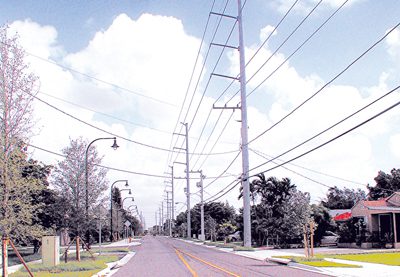

Representatives of Florida Power and Light (FPL) presented an update on two topics of great interest to area businesses and homeowners during the monthly meeting of the Economic Development Council on July 22.
Steve Scroggs, project manager for Turkey Point 6 & 7 discussed the latest information on the expansion of South Florida’s nuclear power plant, and Dan Hronec, transmission project engineer, gave a presentation on the emotionally charged issue of proposed high power transmission lines along S. Dixie Highway.
Attending the meeting were Mayor Eugene P. Flinn Jr., Vice Mayor Brian Pariser and Councilmembers Shelley Stanczyk and Howard Tendrich of Palmetto Bay; Vice Mayor Ed MacDougall of Cutler Bay, and Mayor Cindy Lerner of Pinecrest — leaders of three municipalities that would be impacted directly by the transmission line project. Maria Levant of Miami- Dade County Commissioner Kay Sorenson’s office also was present. The expansion of Turkey Point and production of more power is the main reason more transmission lines are needed.
Scroggs explained that FPL currently uses a mix of fuels, with natural gas representing 64.7 percent, nuclear 23.8 percent and much smaller amounts for coal, oil and solar. He said that they needed to rely more on nuclear power. “We’re exposed to a volatile fluctuation in the price of gas, and that is passed on to the customers as well,” Scroggs said. Hronec, further explained.
“In this area we need more transmission local capacity,” Hronec said. “At peak times of usage, more than 50 percent of power used in Dade County is imported into the county on transmission lines from the north, so the addition of the two nuclear units at Turkey Point and the transmission improvements will allow us to better serve the customer base here in Miami-Dade County.”
Anticipating questions about electromagnetic fields from the lines, Hronec’s presentation covered that as well.
“There have been many studies and there’s no conclusive evidence of any harm from electromagnetic fields,” Hronec said. “We’re constantly surrounded by electromagnetic fields from our TV’s, microwave ovens and our household wiring.
“The limit for maximum magnetic fields at the edge of the right of way for 230 kilovolt lines is 150 milligauss. FPL will meet and, in most cases, be lower than the EMF requirements of the state for its new facilities.”
There are four transmission lines proposed, three in the west part of the county, but it is the one in the east along S. Dixie Highway that most interested those attending the meeting. The question of underground lines was raised by Flinn, Stanczyk and others, and responded to by the FPL reps.
“Transmission lines are much more expensive to build underground than overhead,” Hronec said. “Each case is a custom design, depending on the location. Each entity requesting underground installation must pay for the cost differential. Also, when an underground system fails it’s very hard to determine where the break is, hard to get to it to fix it, and can take weeks compared to hours to restore power.”
Tendrich asked about the pole height and why a community has to pay the difference for putting lines underground. The FPL representatives answered that the poles would be between 80 and 105 feet high, and that it was the Public Service Commission (PSC) and state regulators that had determined that if underground wiring for esthetic needs is requested, it is unfair for those in the other communities to have to share the costs.
Lerner was unconvinced, citing the political power that FPL wields over the PSC and state agencies, and concerned about not only the esthetic aspects of the transmission lines but also the potential harm to village revenue if new businesses choose not to locate along the corridor because of the transmission lines.
“It’s an economic issue as well as an esthetic issue, and we will be presenting an alternate corridor for the transmission lines,” Lerner said. “It’s so important that all of us in the cities affected work together in a joint legal action.”
She urged the other municipal officials to share in that effort and form a united front. MacDougall agreed, but only up to a point.
“I believe that we need a strong South Dade coalition,” MacDougall said later. ”Working together as towns and villages is a plus. This does not mean we will always agree on certain matters. As far as the power lines in Pinecrest north, with our limited budget it would be difficult for Cutler Bay to help pay the expense of Pinecrest’s legal battle with FPL.
“It is my understanding that placing these power lines underground would add approximately $180 million to the expense over the cost of traditional overhead lines. I am all in favor of keeping Pinecrest beautiful, but if the bill for these lines is spread to the immediate utility users, which it will by way of a rate increase, that means the residents of Cutler Bay would be paying a heavy price for power lines nowhere near our town.”
Steve Scroggs pointed out in closing that FPL has spent about $94 million to date in planning the project. If you have questions about the project send them by email to reliabletransmission@fpl.com
This email address is being protected from spam bots, you need Javascript enabled to view it
or call 1-800-693-3267.





